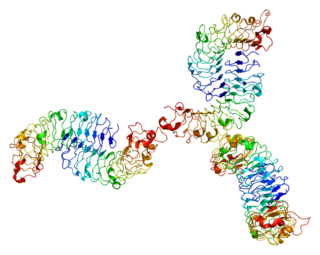
Decorin is a protein that in humans is encoded by the DCN gene.

Biglycan is a small leucine-rich repeat proteoglycan (SLRP) which is found in a variety of extracellular matrix tissues, including bone, cartilage and tendon. In humans, biglycan is encoded by the BGN gene which is located on the X chromosome.

Lumican, also known as LUM, is an extracellular matrix protein that, in humans, is encoded by the LUM gene on chromosome 12.

Keratocan (KTN) also known as keratan sulfate proteoglycan keratocan, is a protein that in humans is encoded by the KERA gene.

WNT1-inducible-signaling pathway protein 1 (WISP-1), also known as CCN4, is a matricellular protein that in humans is encoded by the WISP1 gene.

Fibromodulin is a protein that in humans is encoded by the FMOD gene.

Nyctalopin is a protein located on the surface of photoreceptor-to-ON bipolar cell synapse in the retina. It is composed of 481 amino acids. and is encoded in human by the NYX gene. This gene is found on the chromosome X and has two exons. This protein is a leucine-rich proteoglycan which is expressed in the eye, spleen and brain in mice. Mutations in this gene cause congenital stationary night blindness in humans (CSNB). which is a stable retinal disorder. The consequence of this mutation results in an abnormal night vision. Nyctalopin is critical due to the fact that it generates a depolarizing bipolar cell response due to the mutation on the NYX gene. Most of the time, CSNB are associated to hygh myopia which is the result of a mutation on the same gene. Several mutations can occur on the NYX gene resulting on many form of night blindness in humans. Some studies show that these mutations are more present in Asian population than in Caucasian population. A mouse strain called nob carries a spontaneous mutation leading to a frameshift in this gene. These mice are used as an animal model for congenital stationary night blindness.

Prolargin is a protein that in humans is encoded by the PRELP gene.

Golgin-45 is a protein that in humans is encoded by the BLZF1 gene.

Beta-1,4-galactosyltransferase 7 also known as galactosyltransferase I is an enzyme that in humans is encoded by the B4GALT7 gene. Galactosyltransferase I catalyzes the synthesis of the glycosaminoglycan-protein linkage in proteoglycans. Proteoglycans in turn are structural components of the extracellular matrix that is found between cells in connective tissues.

Opticin is a protein that in humans is encoded by the OPTC gene.

Interphotoreceptor matrix proteoglycan 1 is a protein that in humans is encoded by the IMPG1 gene.

Asporin is a protein that in humans is encoded by the ASPN gene.

Osteomodulin is a protein that in humans is encoded by the OMD gene.

Leucine-rich repeat transmembrane protein FLRT3 is a protein that in humans is encoded by the FLRT3 gene.

Fibronectin leucine-rich repeat transmembrane protein FLRT2 is a protein that in humans is encoded by the FLRT2 gene.

Collagen alpha-1(XXVI) chain is a protein that in humans is encoded by the EMID2 gene.

KIAA0644, also known as TRIL or TLR4 interactor with leucine rich repeats, is a protein that in humans is encoded by the KIAA0644 gene.

Leucine-rich repeat-containing protein 50 is a protein that in humans is encoded by the LRRC50 gene.

Fibronectin leucine rich transmembrane protein 1 is a protein that in humans is encoded by the FLRT1 gene.


















